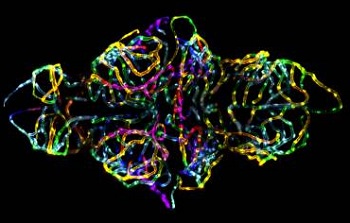THE WINNING image in the 2012 Nikon Small World photomicrography competition is an image of the blood-brain barrier in a live zebrafish embryo, submitted by Dr Jennifer Peters and Dr Michael Taylor of St Jude Children’s Research Hospital.

Nikon Small World winning entry 2012 shows the blood/brain barrier in a live zebrafish
This is thought to be the first-ever image showing the formation of the blood-brain barrier in a live animal.
“Each year, we receive incredible images from all over the world for Nikon Small World, and it is a privilege to honour them,” said Eric Flem, communications manager, Nikon Instruments. “We are proud that this competition is able to demonstrate the true power of scientific imaging and its relevance to both the scientific communities as well as the general public.”
Peters and Taylor used fluorescent proteins to look at brain endothelial cells, and watched the blood-brain barrier develop in real time. “We took a threee-dimensional snapshot under a confocal microscope, the stacked the images and compressed them into one, adding pseudo colour in rainbow to illustrate depth.”
The top five images this year come from a wide variety of artistic visual concepts and scientific disciplines who all share a common goal of outstanding photomicrographs that demonstrate superior technical competency and artistic skill.
Second place goes to Walter Piorkowski for an image of live newborn lynx spiderlings, and third place to Dr Dylan Burnette of the US National Institutes of Health for an image of human bone cancer (osteosarcoma) showing actin filaments, mitochondria, and DNA.
In fourth position is Dr Ryan Williamson of the Howard Hughes Medical Institute (HHMI) with ‘Drosophila melanogaster visual system halfway through pupal development, showing retina, photoreceptor axons, and brain’, while fifth is Honorio Cócera-La Parra, University of Valencia, with an image of the mineral cacoxenite from La Paloma mine, Spain”
